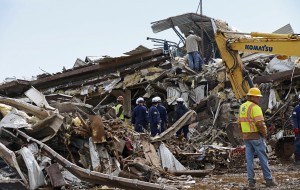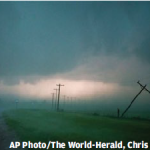Lightweight garage doors can be the weak link that allows high winds and pressure changes into a home during a tornado, according to a study of tornado damage by researchers from The University of Alabama and other institutions.

(Photo/The Oklahoman, Bryan Terry)
Surviving a tornado in a wood-frame residential home is enhanced by an intact roof and standing walls—and wind and pressure changes entering through weak garage doors can blow roofs away and collapse walls, the researchers found based their examination of damage left behind by a powerful tornado Moore, Okla. in 2013.
“Once the roof over the garage is blown off, there usually is a significant hole into the main portion of the house,” said Dr. Andrew J. Graettinger, associate professor of civil, construction and environmental engineering and lead author of a report by a team of researchers.
Researchers from six institutions traveled to Moore at the end of May 2013 as part of the National Science Foundation Rapid Response Grant for Exploratory Research awarded to UA to investigate and gather data about the damage to, and performance of, woodframe structures in the affected areas due to strong winds.
As part of the grant, the research team also studied whether social media and engineering can combine to influence future building practice. Other NSF grants funded work by researchers at three other institutions, and their work is included in the final report.
“We need to consider the building components that are the starting points for damage that lead to loss of life, injuries and economic loss during a tornado,” Graettinger said. “If we engineer for these weak areas, we can start keeping these buildings together during all but the strongest winds a tornado can produce.”
Besides the findings on garage doors, the team found more use of residential shelters in Moore than found in similar studies in Tuscaloosa and Joplin, Missouri, after strong tornadoes hit both cities in 2011. This is likely because the tornado in Moore a year ago was the third major tornado to strike the city since 1999. The conclusion of the study is simple: below-ground storm shelters and above-ground safe rooms protect against the worst storms and save lives.
“They all performed very well,” Graettinger said of the shelters observed in Moore. “That’s important because while progress is made toward crafting building codes to protect against smaller tornadoes, in large storms or when retrofitting existing homes, a safe room is the best option to save lives.”
The EF 5 tornado that struck Moore May 20, 2013, created a 17-mile long damage swath destroying more than 12,000 buildings mostly in residential and light commercial areas. More than 350 people were injured, and 24 people died as a result of the tornado. The total economic loss from this single event was estimated at $3 billion.
Several members of the team worked together in 2011 to study damage left in the wake of massive tornadoes in Tuscaloosa and Joplin. The researcher’s goal after all three events is to better understand the forces generated by large tornadoes and the distribution of wind force across a tornado’s path, as well as make recommendations for design code improvements and general safety guidelines.
From the data collected in 2011, the researchers concluded that light-frame wood structures will not be able to withstand a direct hit from the forces of powerful EF4 or EF5 tornadoes which produce winds stronger than 166 mph. However, based off the three studies, it’s estimated 85 percent of the damage area left behind by an EF4 or EF5 tornado experience winds from EF0-EF2 tornadoes, or winds less than 135 mph.
These areas on the edges of those systems could see dramatic improvements in safety and overall structure through better engineering design and construction practices. The study of the tornadoes in 2011 concluded that applying techniques to build homes against hurricanes is probably the easiest, low-cost solution to strengthening homes against lower-windspeed tornadoes, and safe rooms and shelters are needed to save lives for those in the center of a tornado.
The study of the tornado in Moore reinforced that conclusion, and it vindicates recent research methods of tornadoes in laboratories and numerical analysis. It also led to further investigation of garage doors, especially on garages that extend from the house.
In the areas with lower wind speeds, the root for failure of residential structures was often the garage, according to the Moore damage assessments.
When the garage door is breached during a tornado, it typically leads to pressurization of the garage, subsequent loss of roof over the garage and collapse of the garage walls.
 The biggest difference between the damage assessments in Moore with those in Tuscaloosa and Joplin was the prevalence of storm shelters. In 2011, shelters were not commonly observed by the research team in Tuscaloosa or Joplin.
The biggest difference between the damage assessments in Moore with those in Tuscaloosa and Joplin was the prevalence of storm shelters. In 2011, shelters were not commonly observed by the research team in Tuscaloosa or Joplin.
At the time of the tornado in 2013, the city of Moore had 3,236 registered residential shelters, an estimated 16 percent of housing units in Moore based of 2010 U.S. Census data. In the damage area, researchers examined 75 residential shelters. Of the 75 shelters observed in Moore, 68 were below ground, and all served their purpose, often times with neighbors of the home with the shelter, the team observed.
Only one of the 75 shelters, an above-ground safe room, was penetrated by high-flying debris, a result of errors in building the safe room, the team concluded.
During the research in Moore, social media was used to identify locations to survey damage. It was a novel approach that helped locate the best places to study structural damage, said Dr. Laura Myers, senior research social scientist at The Center for Advanced Public Safety at UA.
“Not only does this assist with the research process, but it also helps establish a community network for storm damage recovery,” Myers said. “Once recovery begins, this community network becomes integral in documenting what the infrastructure strengths were, such as storm shelters, and what needs to change, such as better building codes, to help the rebuilding process.”
The team consists of the following researchers:
- Dr. Andrew Graettinger, principal investigator of the project and associate professor of civil, construction and environmental engineering at The University of Alabama
- Dr. Thang Dao, assistant professor of civil, construction and environmental engineering at UA
- Dr. Jim Richardson, associate professor of civil, construction and environmental engineering at UA
- Dr. Laura Myers, senior research social scientist at The Center for Advanced Public Safety at UA
- Dr. David O. Prevatt, assistant professor of civil and coastal engineering at the University of Florida
- Dr. Rakesh Gupta, professor of wood science and engineering at Oregon State University
- Dr. Arthur G. Cosby, the William L. Giles Distinguished Professor and director of the Social Science Research Center at Mississippi State University
- Dr. Robert Emerson, associate professor of structural engineering at Oklahoma State University
- Dr. Fred Haan, associate professor of mechanical engineering at Rose-Hulman Institute of Technology
Several students were also part of the research team including an undergraduate and three graduate students from UA.
To view the full report along with an interactive map of the damage assessment, visit http://esridev.caps.ua.edu/mooretornado/mooretornado.html
Source: University of Alabama





















 Empowering the ‘Semi-Captive’ Agent: A New Playbook for Insurers
Empowering the ‘Semi-Captive’ Agent: A New Playbook for Insurers  First 2025 Atlantic Hurricane Season Forecasts 7 Named Storms
First 2025 Atlantic Hurricane Season Forecasts 7 Named Storms  2025 Underwriting Profit and ‘Shop-a-Palooza’ Predicted for Auto Insurance
2025 Underwriting Profit and ‘Shop-a-Palooza’ Predicted for Auto Insurance  Are Cars ‘Structures’? Tallying the Damage from the Los Angeles Wildfires
Are Cars ‘Structures’? Tallying the Damage from the Los Angeles Wildfires 




